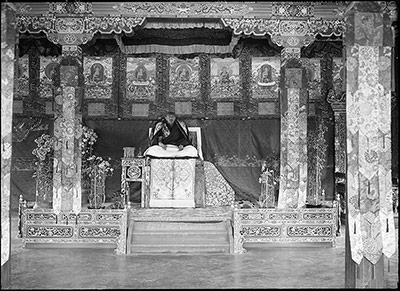
1998.285.85 (Glass negative)


1998.285.85 (Glass negative)

Sir Charles Bell & Rabden Lepcha
Sir Charles Bell
October 14th 1921
Lhasa > Norbu Lingka > Throne Room
1998.285.85
120 x 163 mm
Negative glass plate gelatin , Negative Half Plate
Donated 1983
St Antony's College, Oxford.
Sir Charles Bell's Mission to Lhasa 1920-21
Royal Central Asiatic Society
Sir Charles Bell with Rabden Lepcha
See H.76
BL.H.76a
'Tibet Past & Present', Sir Charles Bell, Oxford: The Clarendon Press, 1924 [view list of illustrations]
Manual Catalogues - Bell's List of Illustrations entry for H.76: "[No. of chapter] V. [Subject of Chapter] Dalai Lama. [Subject of illustration] H76 (u) Dalai Lama on his throne, 4ft high, in Norbu Lingka, as when blessing pilgrims. Behind throne red silk brocade; above it nine silk scrolls, each representing Buddha in the 'earth-pressing' (sa-non) attitude. In front of throne is a dais, 18 ins. high with a balustrade of finely carved woodwork running round it. Hanging down in front of the throne is a white silk cloth embroidered in gold with crossed dorjes. Flowers, i.e., chrysanthemums, marigolds etc., are set round the dais. This is the throne which the DL uses on important occasions. [Where placed - book page] I, 144. [Remarks] L.44 [lantern slide 44] {D.L./Y. in L.}"
In Negative - Bell does not distinguish in his List of Illustrations between H76 a and H76 b. However, 1998.285.86 (H76 b) has had an (unidentified) layer or film added across the non-emulsion side of the glass negative plate, which appears to have the effect of softening the contrast. Key features have then been scratched out of this film to heighten their sharpness and contrast relative to the rest: the brocade coloured pillar in the extreme right foreground, the pillar on the left (facing) of the Dalai Lama and the white silk cloth hanging in front of the throne. A red mask has also been painted over the Dalai Lama's face, from which highlights have been scratched on the nose and cheekbones. This has the effect of making the Dalai Lama's face much clearer in 1998.285.86 than in 1998.285.85
Contemporary Publication - Published in 'Tibet Past & Present', Bell, C. A., Oxford: Clarendon Press, 1924, facing p.144: "The Dalai Lama on his throne in the Jewel Park"
Other Information - Description: Bell's Diary entry for 14th October 1921:"Rabden and I photographed the Dalai Lama this forenoon, sitting on the throne in his throne room, as he would sit when blessing pilgrims. The photos on the whole turned out well. ... This is the throne room that is used on important occasions. // While the room was being arranged the D[alai] L[ama] came in to see that the arrangements were properly made. It was interesting to see him en famille , in his own household. Monk officials, ordinary workmen, went about their work, almost jostling against him, while he wound in and out among them, giving an order here, making a slight change there. Workmen clean and polish the boarded floor by sliding over it boots with large woollen flanges attached, like a ballroom being got ready for a dance." [Diary Vol. XIII, pp. 28-9]
Other Information - Description: Bell describes this occasion in detail “I am to take the Dalai Lama’s photograph again ... the first time that anyone has photographed him in the Holy City (Lhasa)... The arrangement of the throne-room is not ready. I watch them arranging it. The throne is built up of two or three wooden pieces; the nine silk scrolls, representing the Buddha in the earth-pressing attitude, are already placed on the wall behind and above the throne... Below these scrolls red silk brocade covers the wall. The throne is four feet high, a seat without a low balustrade of beautifully carved woodwork running around it. Hanging down in front of the throne is a cloth of rich white silk, handsomely embroidered in gold, with crossed thunderbolts (symbol of equilibrium, immutability and almighty power) ... Chrysanthemums, marigolds and other flowers are arranged round the dais.” ( Portrait of the Dalai Lama .p336)
For Citation use:
The Tibet Album.
"The Thirteenth Dalai Lama on throne in Norbu Lingka"
05 Dec. 2006. The Pitt Rivers Museum.
<http://tibet.prm.ox.ac.uk/photo_1998.285.85.html>.
For more information about photographic usage or to order prints, please visit the The Pitt Rivers Museum.
© The Pitt Rivers Museum